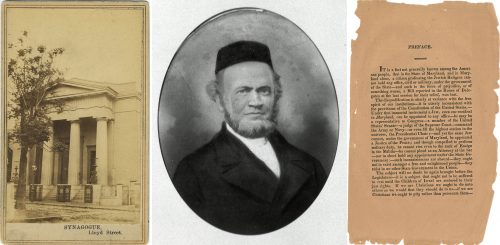Timeline of Baltimore Jewry: 1657 – 1849


1657: Maryland’s first known Jewish colonists appear in the historical record: David Ferera, a trader with links to Amsterdam Jewish merchants, and Jacob Lumbrozo, a Portuguese physician who had been part of the crypto-Jewish community of London.
1658: Lumbrozo becomes the only person ever prosecuted under the colony’s Toleration Act of 1649, which made the denial of Jesus’ divinity a crime punishable by death. Fortunately Lumbrozo is released under a general amnesty before being sentenced. He remains in Maryland and prospers as a physician, trader, and landowner.
1729: Baltimore Town is chartered, though not until the 1750s does the tiny port town begin to grow into a leading commercial center.
1768: Merchant Jacob Hart signs his name to a petition. He is the first known Jew to live in Baltimore.
1773: Benjamin Levy opens a shop on Market Street, advertising liquors, fancy groceries, and dry goods. He, his wife Rachel, and their four children constitute the first known Jewish family to settle permanently in Baltimore.
1780: Widow Shinah Etting and her five children move to Baltimore, where Mrs. Etting opens a boarding house “for gentlemen” on Market Street. Her sons Solomon and Reuben establish the Ettings as one of the prominent Jewish families of early Baltimore.
1786: Around thirty Jews live in Baltimore. They maintain a burial ground on land owned by Charles Carroll and William McMechen, near the present-day corner of Monument Street and Greenmount Avenue.
1797: Solomon Etting and Bernard Gratz petition the Maryland General Assembly to modify the Maryland constitution’s Christian oath requirement for public office, initiating a thirty-year struggle for Jewish civic equality in Maryland.
1803: Widow Judith Cohen moves to Baltimore with her children. Her sons Jacob and Benjamin will join the Ettings as notable early civic and business leaders.
1814: Two Cohens and an Etting are among the American forces at the Battle of Fort McHenry.
1820: Baltimore’s Jewish population reaches 120. A substantial migration of Jews from Bavaria and other German states begins in the 1820s and lasts for decades, peaking in the 1850s. Most of the new arrivals settle near growing market areas, such as Centre Market and Fells Point.
1826: After heated debate, the “Jew Bill” is enacted by the Maryland legislature, modifying the state constitution’s Christian oath requirement for public office. The law allows Jews to substitute a declaration of belief in a Creator. Hagerstown delegate Thomas Kennedy, a non-Jew, leads the fight for the bill. A few months later, Solomon Etting and Jacob Cohen are elected to the Baltimore City Council.
1830: Baltimore Hebrew Congregation becomes the first incorporated Jewish organization in Maryland. It meets in rented rooms over a grocery at Bond and Fleet streets.
1834: The United Hebrew Benevolent Society is chartered in Baltimore, the first Maryland Jewish organization devoted to charitable purposes.
1840: The Baltimore Hebrew Congregation becomes the first in America to have an ordained rabbi when it hires Rabbi Abraham Rice (1800-1862), recently arrived from Bavaria.
1842: Har Sinai Congregation starts meeting at Moses Hutzler’s home in Fells Point as a Reform alternative to the traditionalist Baltimore Hebrew Congregation. It is the first American congregation founded as a Reform congregation.
1843: The Fells Point Hebrew Friendship Congregation becomes Baltimore’s third Jewish congregation, and for a while, the largest. However, it will dissolve around 1900.
1845: Baltimore Hebrew Congregation builds the Lloyd Street Synagogue in East Baltimore, centrally located between Jewish population centers in the downtown area and in Fells Point. It is the first synagogue in Maryland and, today, the third oldest surviving synagogue building in the U.S.
1846: Massachusetts inventor Elias Howe patents the first workable sewing machine, revolutionizing the clothing industry. The following decade, German Jewish entrepreneurs establish small clothing manufacturing firms that will become the basis of Baltimore’s garment industry. Companies founded by Henry Sonneborn and Levi Greif will become among the nation’s largest.
1849: Har Sinai Congregation builds the first Reform temple on the American continent on North High Street in East Baltimore (no longer standing).
1849: Rabbi Rice resigns from Baltimore Hebrew Congregation, dismayed by his congregants’ growing religious laxity. Lamenting that desecration of the Sabbath, violation of dietary laws, and intermarriage have become rampant among Jews in America, he famously writes to his mentor in Germany, “My mind is perplexed and I wonder whether it is even permissible for a Jew to live in this land.” Traditionalists at Baltimore Hebrew nevertheless maintain control over the ritual life of the congregation. Two years later Rabbi Rice founds a small, strictly Orthodox congregation at his home, which will eventually grow into Congregation Shearith Israel.
Continue to A Timeline of Baltimore Jewry: 1850-1889
For a more detailed history of Jewish Baltimore, particularly 1950 – present, please check out On Middle Ground by Dr. Eric L. Goldstein and Dr. Deborah R. Weiner. Copies available online at Esther’s Place, the JMM gift shop.
